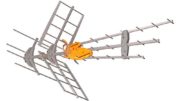If you’re making your first steps into the world of TV antennas, you’ve probably noticed that there are two types of antennas. UHF antennas claim to pick up channels 14-35 and UHF/VHF antennas claim to pick up channels 2-35. (There are some UHF/VHF antennas that only make a claim of picking up channels 7-35, because you need a really big antenna to pick up 2-6 effectively.)
Now, there’s a lot of information there, and before we start there’s something else to talk about. The channel number you think you’re getting probably isn’t the channel number you’re actually getting. About 15 years ago, the US adopted a system called PSIP so that stations could change frequencies and keep their channel numbers. You can read more about that here. If you want to know more, use a site like TVFool.com to find out what real channels are being used for the stations you watch over the air.
Why UHF and VHF
A long long time ago, there were only 13 channel slots. No one thought they would need more. Almost immediately, channel 1 was taken away from broadcast use. (Admit it, you’ve always wondered why.) But, broadcasting equipment was pretty primitive back then, and it turns out you couldn’t have two broadcasters on adjacent frequencies. So, of the 12 usable channels, only about 5 of them could actually be used in most markets. The rest were used by adjacent markets.
That’s why, in 1952, UHF frequencies were released for television use. Originally there were more of them, but it turns out they weren’t needed so the frequencies were taken for cellular and first responder use, leaving us with the ones we have today.
Today, the distinction between UHF and VHF isn’t really important unless you’re shopping for an antenna. It used to be that you used two different knobs on your TV, one for VHF and one for UHF. Today it’s all a push of a button.
Why antennas are called UHF-only or UHF/VHF
There’s a lot of physics that goes into an antenna. Here’s the part you really need to know about. All TV channels (in fact, all broadcasts) take place on a particular frequency. Think of AM/FM radio, where the frequencies are part of the name of the station. For example, in the Detroit area, we like to listen to WRIF on 101.1MHz. That’s the frequency of the broadcast.
Each frequency corresponds to a different wavelength. As the frequency numbers go up, the wavelengths go down. And when I say wavelength, it’s literally the length of a wave. People use the word wavelength all the time and don’t realize it’s pretty literal. For example, the radio waves for TV channel 7 measure about 6 feet from peak to peak. The radio waves for TV channel 34 measure about 19 inches from peak to peak.
Here’s why that’s important.
In order for an antenna to work really well, it has to be an even fraction of the wavelength. To receive channel 7 really well, you need an antenna that’s about 3 feet wide, or 1.5 feet wide, or if you’re really serious, 6 feet or 12 feet wide. And, that’s how antennas are designed. The fractional amount doesn’t have to be perfect, which is how you can have one antenna that works with multiple channels.
So UHF antennas are designed so they receive UHF frequencies really well, while UHF/VHF antennas are designed to receive both UHF and VHF frequencies really well. They do this by combining an antenna that receives UHF frequencies really well with one that receives VHF frequencies really well.
A word about indoor antennas
Indoor antennas will generally advertise themselves as UHF/VHF antennas. Truth is, indoor antennas don’t work terribly well for UHF or VHF. But if you’re close enough to the towers that you’re considering an indoor antenna, it doesn’t matter.
Because the dirty little secret of antennas is that pretty much anything made of metal, from a coat hanger to a lamp, can pick up a signal if that signal is strong enough. If that signal is strong enough it won’t matter what size or shape the thing is, as long as it’s made of metal that can receive the signal. So, an indoor antenna will typically say it’s UHF/VHF based on that.
And that brings us to the point (finally.)
Most UHF antennas will receive VHF signals, practically by accident. It just so happens that the size of the antenna will be a fairly close match to some VHF channels. Most UHF antennas don’t have filters to prevent them from sending VHF signals to your TV, either. That would be an added expense.
It depends on the antenna of course, but in general you can expect a UHF channel to pick up antennas at about one quarter of its rated range. If you have a UHF antenna rated for 60 miles, it will probably pick up VHF channels 15 miles away. As I said, when you get close enough to the towers practically anything will pick up a signal.
Shopping for an antenna?
If you’re looking for an antenna, you don’t have to go it alone? Fill out this form for a custom antenna recommendation that will include the right UHF-only or UHF/VHF antenna!





